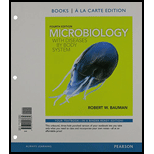
To explain:
How the (syphilis) patients infected with the malarial parasites for inducing high fever often recovered from the syphilis infection.
Introduction:
The microbe Treponema pallidum is the infectious agent of the disease syphilis. Despite several efforts that have been made for centuries, the scientists failed to provide the culture conditions in a laboratory required by the bacterium. This bacterium requires host cell for its growth and survival. Therefore, this bacterium can be grown only in the living cells (rabbit) and cannot be cultured in the laboratory. Most of the microbes have never been grown in any culture media.
Want to see the full answer?
Check out a sample textbook solution
Chapter 6 Solutions
Microbiology with Diseases by Body System, Books a la Carte Edition & Modified Mastering Microbiology with Pearson eText -- ValuePack Access Card
- Bacilli, which are rod-shaped, spore-forming bacteria, cause _____________________. Lyme disease measles rubella anthraxarrow_forwardA large hospital washes burn patients in a stainless steel tub. After each patient, the tub is cleaned with a quat. It was noticed that 14-20 burn patients acquired Pseudomonas infections after being bathed. Provide an explanation for this high rate of infection.arrow_forwardEven though genetically engineered mosquitoes might be developed that do not allow the reproduction of malaria protozoa, these mosquitoes would have little, if any, immediate effect on the spread of the disease. Why should this be so? What would have to happen for these mosquitoes to significantly affect the spread of malaria?arrow_forward
- An obsolete treatment for syphilis involved inducing fever by deliberately infecting patients with the agent of relapsing fever. An experimental AIDS treatment involved infecting patients with malaria to induce high fevers. Can you provide some possible explanations behind these peculiar forms of treatment?arrow_forwardPlague has been successfully controlled by the use of streptomycin and tetracycline Why was this disease so lethal in the years 600when antimicrobial drugs were not available?arrow_forwardHello, good day. I have a problem answering this question, and I need your help. Hoping for a response, and thank you so much. Instruction: Read Chapter 5. The Hemoflagellates of the book Clinical Parasitology: A Practical approach by Zeibig and answer the question: Question: In what ways are Leishmania and Trypanosoma similar with each other?arrow_forward
- AIDS is a well-known infectious disease, but respiratory and diarrheal diseases claim far more lives every year than AIDS. According to the figure, how many times more lives were lost to respiratory infections and diarrheal diseases than to AIDS?arrow_forwardIf endotoxin can not convert to toxoids how can we treat endotoxin?arrow_forwardSea otters are being affected by a disease call toxoplasmosis. What causes this disease? What organisms does it affect?arrow_forward
 Medical Terminology for Health Professions, Spira...Health & NutritionISBN:9781305634350Author:Ann Ehrlich, Carol L. Schroeder, Laura Ehrlich, Katrina A. SchroederPublisher:Cengage Learning
Medical Terminology for Health Professions, Spira...Health & NutritionISBN:9781305634350Author:Ann Ehrlich, Carol L. Schroeder, Laura Ehrlich, Katrina A. SchroederPublisher:Cengage Learning Human Heredity: Principles and Issues (MindTap Co...BiologyISBN:9781305251052Author:Michael CummingsPublisher:Cengage LearningCase Studies In Health Information ManagementBiologyISBN:9781337676908Author:SCHNERINGPublisher:Cengage
Human Heredity: Principles and Issues (MindTap Co...BiologyISBN:9781305251052Author:Michael CummingsPublisher:Cengage LearningCase Studies In Health Information ManagementBiologyISBN:9781337676908Author:SCHNERINGPublisher:Cengage Comprehensive Medical Assisting: Administrative a...NursingISBN:9781305964792Author:Wilburta Q. Lindh, Carol D. Tamparo, Barbara M. Dahl, Julie Morris, Cindy CorreaPublisher:Cengage Learning
Comprehensive Medical Assisting: Administrative a...NursingISBN:9781305964792Author:Wilburta Q. Lindh, Carol D. Tamparo, Barbara M. Dahl, Julie Morris, Cindy CorreaPublisher:Cengage Learning





